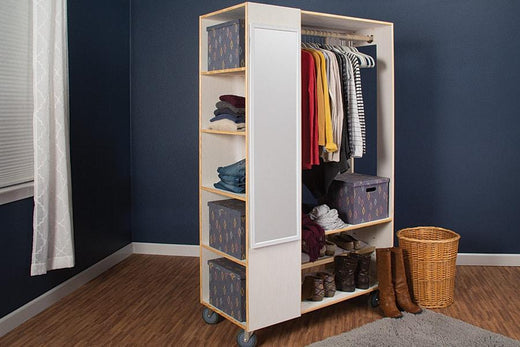Kapid on nagu kartulikrõpsud. Pole tähtis, kui palju teil on, oleks alati tore, kui teil oleks veel vaid üks. Muidugi on teise kapi jaoks ruumi leidmine keeruline, kui mitte võimatu. Sellepärast on see eraldiseisev kapp suurepärane. See pakub lisakappi kõikjal, kus seda vajate.

Raskus : Mmõõdukas
Materjalid:
Puidutooted
- 2 vineerilehte → 19 mm paksune, täisleht
- 5 tahvlit → 19 mm x 140 mm x 2100 mm
- 1 tüübel → 32 mm Läbimõõt x 900 mm
- 6 Ekraani liistud → 6 mm x 19 mm x 2400 mm
Riistvara ja tarvikud
- 149 Kreg 32 mm jämeda keermega tasku-augu kruvid
- 4 130 mm (või samaväärset) lukustusratast
- 1 kapivarda kronsteini komplekt
- 1 Ripppeegel
- 50 25 mm Brad Naelad (ääristamise jaoks)
Lõika loend ja osad
- 1Alumine välimine täiteaine, 19 mm kiht x 248 x 483 mm
- 1Ülemine välimine täiteaine, 19 mm kiht x 248 x 140 mm
- 2Välisraam, 19 x 140 x 1830 mm mänd
- 1Nurgaraam, 19 x 140 x 1830 mm mänd
- 1Tagapaneel, 19 mm kiht x 483 x 1830 mm
- 1Esipaneel, 19 mm kiht x 362 x 1830 mm
- 1Ülemine paneel, 19 mm kiht x 508 x 1187 mm
- 1Alumine paneel, 19 mm kiht x 508 x 1187 mm
- 1Alumine sisetäitematerjal, 19 mm kiht x 229 x 464 mm
- 1Ülemine sisemine täiteaine, 19 mm kiht x 229 x 140 mm
- 2Sisemine raam, 19 x 140 x 1792 mm mänd
- 4Riiul, 19 mm kiht x 343 x 508 mm
- 1Keskmine riiul, 19 mm kiht x 508 x 826 mm
- 1Kingariiul, 19 mm kiht x 356 x 826 mm
- 1Shoe Stop, 6 x 32 x 826 mm männipuidust liist
- 1Kapivarras, 32 mm tüübel, sobivaks lõigatud
- 1Vineerist ääris, 6 x 19 mm ekraaniliist, sobivaks lõigatud



Juhised
-
1 – Looge väliseid raamitäiteid
Lõika 19 mm vineerist üks alumine välimine täiteaine ja üks ülemine välimine täitematerjal, nagu on näidatud lõikeskeemil. Seadke taskuauguga rakis 19 mm paksusele materjalile ja puurige seejärel täiteavadesse taskuaugud. Nende taskuaukude täpne asukoht ei ole kriitiline, lihtsalt asetage need umbes nagu näidatud.
2 - Pange välisraam kokku
Järgmisena lõigake 19x140 mm plaatidest kaks välimist raami. Kontrollige veelkord plaatide pikkust. Seejärel ühendage välimised raamid ülemise välimise täitematerjaliga ja alumise välimise täitematerjaliga, kasutades 32 mm jämeda keermega taskuava kruvisid, et luua väliskoost. Lihvige koost vastavalt vajadusele siledaks, kasutades 120-teralisusega liivapaberit.
3 - Looge nurgaraam
Nüüd kinnitage nurgaraam välisraami külge, kasutades 32 mm jämeda keermega taskuaugu kruvisid, nagu näidatud.
4 - Kinnitage nurgaraam
Nüüd kinnitage nurgaraam välisraami külge, kasutades 32 mm jämeda keermega taskuaugu kruvisid, nagu näidatud.
5 - Tehke ülemine, alumine, esiosa, tagaosa
Lõika 19 mm vineerist üks ülemine paneel ja üks alumine paneel, nagu on näidatud lõikeskeemil. Samal ajal saate lõigata ka taga- ja esipaneeli. Lülitage praegu tagapaneel ja esipaneel kõrvale. Järgmisena määrake ülemise ja alumise paneeli taskuaukude asukohad, nagu näidatud. Märkate, et need paneelid on üksteise "peegelpildid". Nende paneelide puhul on olulisem paigutada taskuaugud kindlaksmääratud kohtadesse. Nii et võtke aega, et need välja panna. Seejärel puurige kõik augud. Lihvige tükid vastavalt vajadusele.
6 – Käivitage korpuse komplekt
Asetage tagapaneel ja välis-/nurgasõlm tasasele tööpinnale, nagu näidatud. Asetage ülemine paneel, nagu näidatud, ja seejärel kinnitage see taga- ja nurgakoostu külge, kasutades 32 mm jämeda keermega taskuava kruvisid.
7 – Looge sisemised raami täitematerjalid
Lõika 19 mm vineerist üks alumine sisetäidis ja üks ülemine sisetäitematerjal, nagu on näidatud lõikeskeemil. Kui taskuauguga rakis on endiselt seadistatud 19 mm paksuse materjali jaoks, puurige täiteavadesse taskuaugud, nagu näidatud. Veelkord, nende taskuaukude täpne asukoht ei ole kriitiline. Lihvige tükid vastavalt vajadusele.
8 - Looge sisemised raamid
Lõika 19x140 mm plaatidest kaks siseraami pikkuseks, nagu on näidatud lõikeskeemil. Puurige igasse plaati näidatud kohtadesse taskuaugud. Lihvige tükid vastavalt vajadusele.
9 - Kinnitage siseraam
Kinnitage sisemine raami koost ülemise paneeli ja tagapaneeli külge, nagu näidatud. Veenduge, et raam oleks sirge. Näete, et see koost peatub tagapaneeli alumisest otsast 19 mm kaugusel. See on õige. Alumine paneel mahub sellesse vahesse.
10 - Pange siseraam kokku
Nüüd saate sisemiste raamide külge kinnitada ülemise sisetäidise ja alumise sisetäitematerjali, kasutades 32 mm jämeda keermega taskuava kruvisid. Enne kui keerate kõik kokku, veenduge, et kõik taskuaugud on õigesti orienteeritud.
11 - Kinnitage alumine ja esiosa
Põhikorpuse lõpuleviimiseks peate lihtsalt kinnitama alumine paneel ja esipaneel, kasutades 32 mm jämeda keermega tasku-augu kruvisid. Kinnitage esmalt alumine osa, seejärel lisage esiosa, nagu näidatud.
12 – Tehke riiulid
Järgmiseks on aeg lisada riiulikomplekt, mis mahub esi- ja tagapaneeli vahele. Lõika 19 mm vineerist neli riiulit sobivasse mõõtu, nagu on näidatud lõikeskeemil. Seejärel puurige taskuaugud kõigisse nelja riiulisse, nagu näidatud. Pöörake tähelepanu kahele taskuaugule tagaservas. Need peavad asuma riiuli otstest 115 mm raadiuses, et kruvid riiulite paigaldamisel vastu siseraamisid tabaksid. Lihvige tükid vastavalt vajadusele.
13 - Paigaldage riiulid
Asetage riiulid näidatud kohtadesse ja seejärel kinnitage need esi-, taga- ja siseraami külge, kasutades 32 mm jämeda keermega taskuava kruvisid.
14 - Tehke ülejäänud riiulid
Viimased täiendused eraldiseisvale kapile on veel üks riiulite komplekt: keskmine riiul ja kingariiul. Lõika need riiulid 19 mm vineerist sobivaks, nagu on näidatud lõikeskeemil. Puurige riiulitesse taskuaugud näidatud kohas. Pöörake tähelepanu taskuaukude asukohale piki iga riiuli tagumist serva. Lõika ka üks Shoe Stop 6x32mm männivõrest, nagu on näidatud lõikeskeemil. Liimige ja naelutage jalatsihoidik kingariiuli esiserva külge, nii et see jääks pinnast kõrgemale. See hoiab ära jalatsite libisemise riiulilt, mis paigaldatakse nurga all. Lihvige tükid vastavalt vajadusele.
15 - Paigaldage ülejäänud riiulid
Kinnitage keskmine riiul näidatud kohta, kasutades 32 mm jämeda keermega taskuava kruvisid. Seejärel asetage jalatsiriiul (lühipeatusega ülespoole) ja kinnitage ka see.
16 - Värvige ja lisage valikuline ääris
Kui kokkupanek on lõpetatud, saate otsustada, kuidas soovite oma eraldiseisvat kappi viimistleda. Valisime lamedate pindade värvimise ja jätsime servad loomulikuks. See annab huvitava välimuse, kuid paljastatud vineeriservad ei näe nii head välja kui täispuidust servad. Kui soovite need kinni katta, lõigake lihtsalt ekraaniliistud tükid ning seejärel liimige ja naelutage need vineeriservade külge. Kandsime selle esi- ja tagapaneeli servadele, üla- ja alaosale, neljale riiulile ning keskmise ja kingariiuli katmata servadele.
17 - Lisage riputusvarras ja rattad
Lõpuks lõigake 32 mm tüüblist Closet Rod pikkuseks, nagu on näidatud lõikeskeemil. Seejärel saate varda paigaldada kapivarda riistvara abil ja kinnitada rataste komplekti. Valisime oma eraldiseisvasse kappi suured tööstuslikus stiilis lukustatavad rattad. Lisasime esipaneelile ka peegli.


















Osa:
Lihtne täisplatvormi voodi
Kuidas ehitada kingariiul - DIY kingariiuli plaan